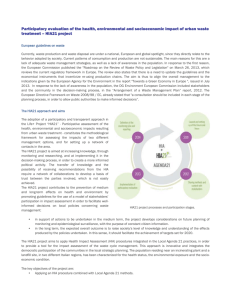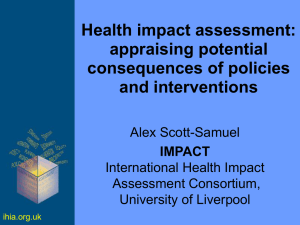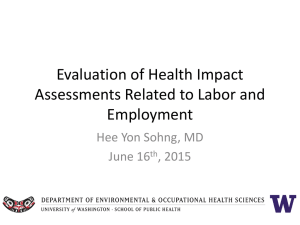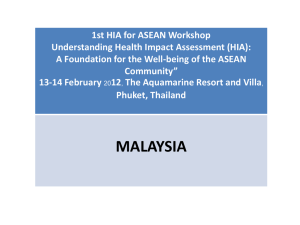HIA: HIA: A Tool to Achieve Public Health Goals Academy Health, 2010
advertisement
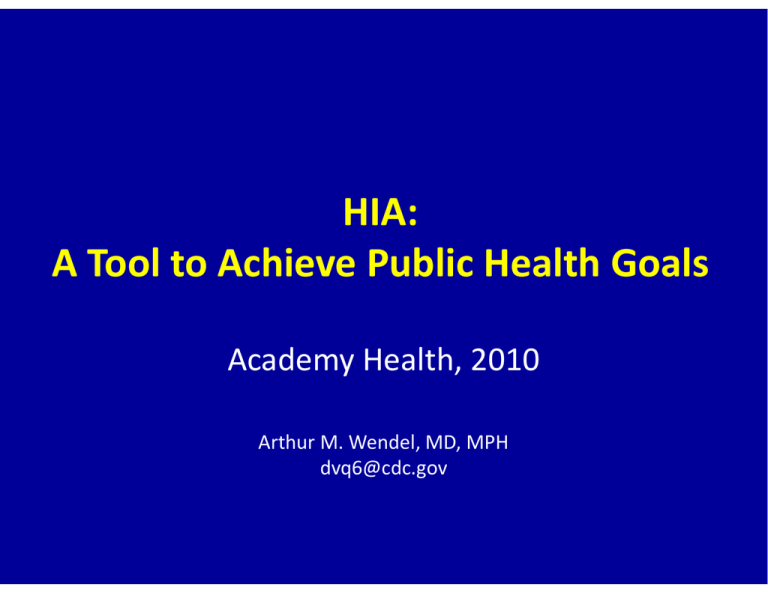
HIA: HIA: A Tool to Achieve Public Health Goals Academy Health, 2010 Academy Health, 2010 Arthur M. Wendel, MD, MPH Arthur M Wendel MD MPH dvq6@cdc.gov Disclaimer The findings and conclusions in this presentation are those of the author(s) and do not necessarily represent the views of the Centers for Disease Control and Prevention. Community Design’ss Impacts Community Design Impacts Core Components of Community Design Environmental and Behavioral Impacts Air Quality Related Leading Causes of Death - Children Unintentional Injuries Cancer Water Quality/Quantity Water Quality/Quantity Transportation Systems Access to Greenspace Land Use Housing Related Leading Causes of Death - Adults Heart Disease Destination and Transportation Options Cancer Cerebrovascular Disease (Stroke) Zoning and Community Development Physical Activity Nutrition/Food Access Unintentional Injuries j Diabetes Health Impact Pyramid Ed Education ti Increasing P Population l ti Impact Clinical I t Interventions ti Increasing Individual Effort Needed Long-lasting Long lasting Protective Interventions Changing the Context to make Individuals’ Default Decisions y Healthy Socio-Economic Factors Frieden, AJPH, 2010 HIA as a Pre-op Physical for Communities http://www.phoenix5.org/humo r/CartoonOperation.html Choices Source: Atlanta Journal-Constitution, March 10, 2006 The 10 Essential Public Health Services CDC’s CDC s Involvement with HIA • CDC Health and Built Environment workshop, p, 2002 • Identified HIA as promising area for research • CDC/RWJF HIA workshop, workshop Princeton, Princeton 2004 • Developed agenda for HIA research and practice p identified still relevant in 2010 • Manyy topics • HIA activities at CDC during 2003-2010 • • • • • • Training g Tracking Funding – NACCHO, APA, ASTHO, NNPHI, IOM Technical assistance Evaluation Policy – Transportation policy recommendations HIA Capacity Building • Piloted in 2008-2009 in Oregon g • • • • Partnered with ASTHO 175 practitioners trained 3 local HIAs begun Indicators developed for incorporation into Tracking network • Expanded to 4 states (OR (OR, CA CA, WI WI, MN) in 2010 • Work ongoing • All have conducted trainings and begun local HIA Completed HIAs in the United States 1999–2009 ((N = 53)) WA 4 MT 1 MN 5 OR 2 MA 2 PA 1 OH 1 NJ 1 CO 2 CA 25 MD 1 GA 4 AK 3 FL 1 Completed HIAs in the United States 1999-2009 (n=53) 18 16 14 12 10 8 6 Number of HIAs Number of HIAs 4 2 0 1999 2000 2001 2002 2003 2004 2005 2006 2007 2008 2009 Source: CDC HIA tracking database as of May 24, 2010 (may be incomplete) Wh t Are What A Best B t Practices? P ti ? • Selection of the HIA • Methodology of the HIA M th d Methods • Identified U.S. HIAs – Previous work identified 27 completed HIAs – Queried HIA practitioners • Data sources – Extracted from written reports – Interviews and/or e-mail exchanges with practitioners Types ypes o of HIA Effectiveness ect e ess Decisions modified due to HIA YES Health issues Direct effectiveness: Changes made because of adequately HIA acknowledged YES NO Opportunistic effectiveness: Health-promoting choice made anyway NO General effectiveness: HIA acknowledged but changes not made; health awareness raised No effectiveness: HIA ignored Wismar M, et al. Effectiveness of HIA. WHO, 2007 R Results lt • Obtained written materials on 53 HIAs • Through interviews, reported effectiveness on 35 HIAs R Results lt • St Studied di d HIAs HIA were conducted d t db between t 1999 19992009 • Unit U it off analysis l i (N (N=53) 53) – 18 project – 22 policy li – 1 program • Geographic G hi scale l (N (N=53) 53) – – – – 27 subsection of a city 16 metropolitan area or region in a state 9 state-wide 1 national R Results lt • HIA depth (N=53) – 14 rapid – 14 intermediate – 24 comprehensive – 1 other • Conducting C d ti organization i ti (N (N=53) 53) – 24 Health Department – 14 Consultant – 22 Academic – 8 Other R Results lt • HIA timing (N=35) – 30 prior or during the decision – 5 after the decision • 2 not intended to be timely • 15 HIAs had explicit decision-maker support (N=35) • 8 HIAs were intertwined with an EIA ( (N=35) ) HIA Effectiveness Rating Changed g Project j Total: 25 Educated Decisionmakers Total: 9 Reinforced Decision No effectiveness Total: 0 Total: 1 Characteristics of HIAs by y Effectiveness Type Direct Di N=25 Generall G N=9 No Eff N Effect N=1 Decision-maker(s) support HIA 13 (52%) 2 (22%) 0% Community involved 17 (68%) 6 (67%) 1 (100%) Vulnerable populations addressed 21 (84%) 7 (78%) 1 (100%) New data collected 8 (32%) 1 (11%) 1 (100%) Quantification Q tifi ti off any health impact 8 (32%) 5 (56%) 1 (100%) Characteristic HIA Depth p by y Effectiveness Rapid Intermediate Comprehensive Direct 10 5 9 General 3 2 4 O Opportunistic t i ti 0 0 1 D fi i Success Defining S • Multiple p routes for success – Directly changing the project or policy – Influencing other projects or policies – Create more demand or supply – Expanding the field of HIA • Conducting an HIA elevates health Li it ti Limitations • Effectiveness based on self-report p from practitioners • Few U.S. HIA practitioners • Written reports varied in scope and content • Established definitions of HIA characteristics lacking Summary • Rapid HIAs can be effective • Decision-maker support more common among directly di tl effective ff ti HIAs HIA • Communityy involvement needs further examination • HIA likely to improve decisions Barriers for Public Health • • • • • • • Lack of support, political and financial Limited training and capacity Viewed as outside subject area Political hazards Different geographical boundaries Data may lack granularity Determining where HIA fits Future HIA Activities Future HIA Activities • Near‐term – Expanded capacity building p p y g – Integration with partners – Indicator and surveillance development Indicator and surveillance development • Long‐term – Finding a place for HIA‐like activities – HIA as part of a comprehensive strategy to HIA as part of a comprehensive strategy to improve health – Integrating health criteria into project selection Integrating health criteria into project selection Moving Science Forward • Basic research • Research synthesis – Community Guide to Preventive Health Services – NYC NYC’s s Active Design Guidelines – Healthy Development Measurement Tool • Surveillance S ill • Evaluation Advocating for Health Advocating for Health • Need evidence‐based decisions, not decision‐ based evidence • Standardization of practice could help S d di i f i ld h l • Effective communication of uncertainty • Relationships with decision Relationships with decision‐makers makers important important Conclusions • • • • Still much to learn State health departments can spur HIA growth State health departments can spur HIA growth Need to coordinate with partners Consider the essential services Thank you Thank you Questions • How to build the market for HIAs • What to do with other HIA What to do with other HIA‐like like projects projects • Where to focus HIA ‐ project or policy?



